[/caption]
Talking with the astronauts living in the NEEMO habitat – NASA’s Extreme Environment Mission Operations – is a bit like talking with Darth Vader; there’s a regular hiss of air intake and outflow in the background. But the ever-present pastel blue hue in the webcam feed lets you know these astronauts aren’t in space. They are living and working in an underwater habitat, 20 meters (70 feet) under the ocean, just off the coast of Key Largo, Florida. What are NASA astronauts doing under the sea?
“This is the closest thing to spaceflight I’ve ever had in all my NASA training,” astronaut Tom Marshburn told Universe Today in the midst of his 14-day stay in NEEMO. “It is very real. Our lives are completely dependent on our habitat, we have to follow checklists and procedures to be safe, we have to watch out for each other, we’re in a tight confined space and doing real work that will help future space missions. So, in all ways it is much like spaceflight, including having a great view out the window.”
Except in space, there wouldn’t be a giant grouper peering through the portal.
The habitat, called Aquarius, is the world’s only undersea laboratory. Mainly it is used for marine research but NASA has found it has great utility for training crews to live in space. “It’s the closest thing to spaceflight without going to space,” Marshburn said. “We’re able to do operational research, work that is applicable to what we need to know about flying in space. We also do life sciences research and some marine research.”
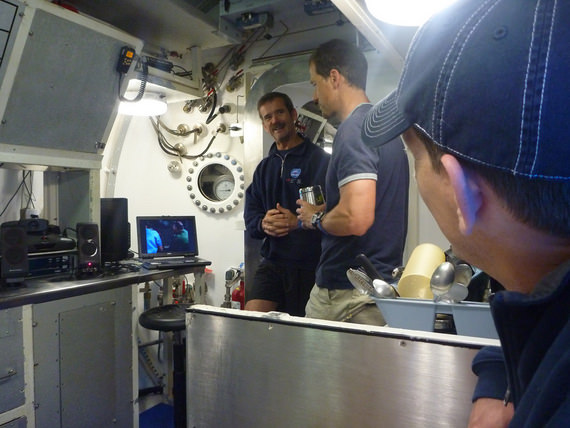
Joining Marshburn is Canadian astronaut Chris Hadfield, who is the commander for this undersea mission, as well as the Lunar Electric Rover Deputy Project Manager Andrew Abercromby and Steve Chappell, a research scientist, along with two technicians.
Aquarius itself is a long cylinder, “like a couple of Winnebagos set end to end,” Marshburn said, with a box-like entry at one end called the Wet Porch.
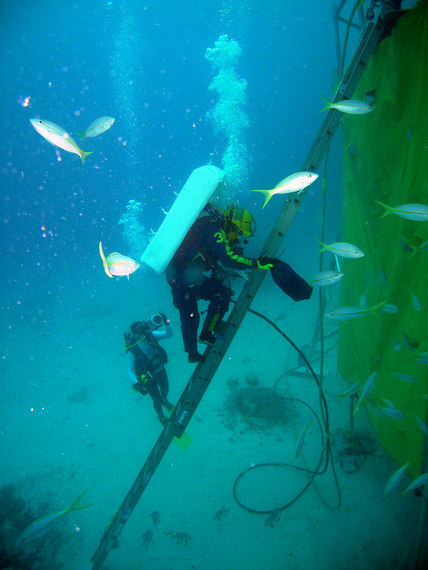
“When we dive into the Wet Porch, there is no hatch. The air pressure keeps the water out. There is cool pneumatic sliding door like something out of Star Trek, and you just walk on in. There’s a galley where we eat backpacking type food, we sleep in a bunk room. There’s six of us in a room about the size of a closet. You get to know your crewmates really well.”
The main working area of Aquarius is filled with valves, dials and lit panels. “It’s a lot like a spaceship,” Marshburn said.
Marshburn and Hadfield are members of the 14th NEEMO crew. The tasks and objectives for their mission, besides giving them training for a long-duration space mission is to do operational research on spacesuits for different gravity and environment requirements (on an asteroid, Mars or on the Moon).
“As you may know, astronauts train underwater in spacesuits, so this is a great place to work on spacesuit design,” said Marshburn, “specifically finding where the center of gravity is and what mobility issues there might be. Instead of just diving in the pool, it turns out we can get a lot more done by being down here and going out with the equipment on the sea floor, and be able to spend hours working on spacesuit design.”
The NEEMO 14 crew is doing intense research on the center of gravity and how that affects the ability to perform standard tasks, and helping spacesuit designers increase range of motion and maintain the comfort level for the astronauts on different planetary surfaces.
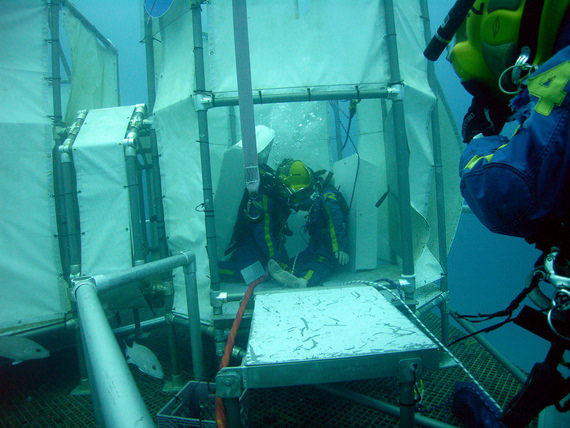
“If we want to explore an asteroid, how do you move around without handholds or something to grab on to?” said Hadfield in a press conference from Aquarius. “Where should the center of mass be for mundane tasks like picking things up or shoveling, or for complex tasks like rescuing a injured crew member? We’re finding that sometimes the center of gravity that is completely wrong on Earth — that would give you a backache in a matter of minutes — works better in a different gravity environment. And that’s what we are trying to figure out. If what we’re finding out is a surprise, that means our simulation is really doing its job.”
The suits can be weighted out to simulate different gravity. The crews do “EVAs” — like spacewalks, going outside every morning and afternoon.
On the ocean floor are also mockups of a lunar rover and lander. Tests for these include hatch design, and ingress and egress simulations. The crew is also doing life sciences experiments, themselves being the subjects. “We’re in a hyper-oxygen environment,” said Marshburn, “that plus living in a confined environment is a lot like living in space and it puts our bodies under stress, so that is being studied, as well as psychological studies. We’re trying to maximize our time down here, so we’re also doing marine geology research.” They also do regular maintenance of the exterior of the habitat.
Marshburn said future designs for spacesuits, rovers, and landers will be based, in part, on what is learned from the NEEMO missions.
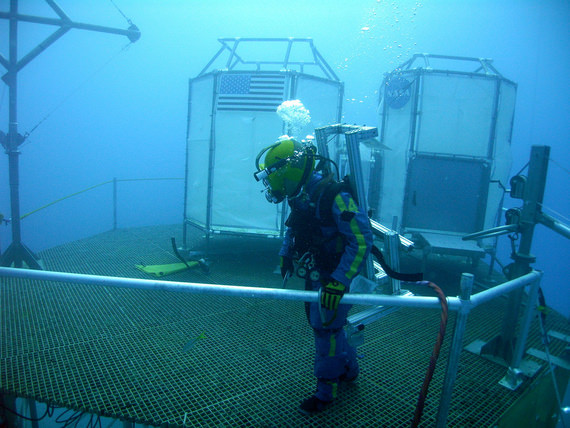
This past week the crew has been in a Mars communication simulation, where there is a 20 minute delay each way for messages – both written and spoken — back and forth from “ground control” on the Earth’s surface. “That has really changed things,” Hadfield said, “it increases our level of isolation. It’s just the six of us with each other with only peripheral help. It forces us to make our own decisions.”
However, the crew has been Twittering during the mission is real-time, an activity Hadfield said he was initially suspicious of. “Twittering was foreign to me, and I only knew it would increase the crew’s work load.”
But what does he think about it now?
“I am delighted with what it has done,” Hadfield said, “not only with our ability to interact with the world, but it forces us to express what we are thinking about. This experience, and the experience of spaceflight is so remarkable that you really shouldn’t horde something that is important to you, or something remarkable that happens. So thousands of people now are following what we are doing down here. This new technology to spread the human experience has allowed us to better articulate to each other, too.”
Hadfield said he is a big proponent of Twitter now, as schools and other organizations have been able to be part of the NEEMO 14 mission.
The mission started on May 10, and the crew will “depressurize” over the weekend to prepare for returning to the surface early next week. It takes at least 16 hours to get the excess oxygen out of their blood. If there would be an emergency, there are backup plans for getting the crew out and keeping them underwater and depressurizing.
Hadfield will be taking a turn on a future long duration space station mission and Marshburn said he is in line for tour of duty on the ISS as well.
“This is best spaceflight simulation I’ve ever had,” he said. “NASA likes to keep their astronauts trained, and believe me, this is worth it. It is very cool.”
Webcams from Aquarius.
Follow NASA_NEEMO on Twitter
See more images from NEEMO 14 on NASA’s Flickr page.

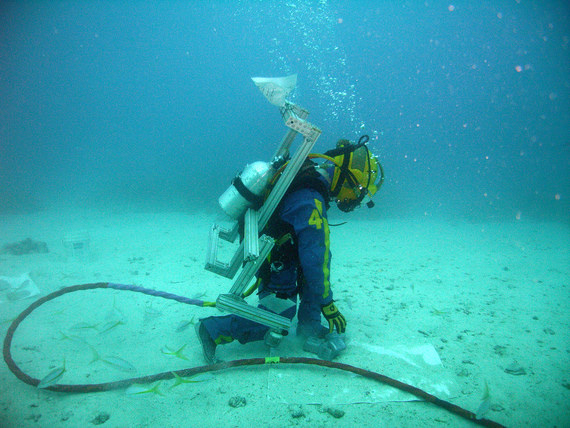
There may soon be a link between this story and one from a few days ago called Satellite Images Show Oil Slick on the Move Towards Florida, Possibly East Coast of US.
Aquarius is located at Conch Reef, 4 miles offshore in the Florida Keys National Marine Sanctuary.
The suit bears a strange resemblance to the Vault suits from the Fallout series of computer games.
Literally the coolest thing in the world. I wants to go there.